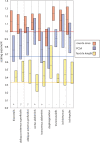Scaling of axial muscle architecture in juvenile Alligator mississippiensis reveals an enhanced performance capacity of accessory breathing mechanisms
- PMID: 34302302
- PMCID: PMC8602021
- DOI: 10.1111/joa.13523
Scaling of axial muscle architecture in juvenile Alligator mississippiensis reveals an enhanced performance capacity of accessory breathing mechanisms
Abstract
Quantitative functional anatomy of amniote thoracic and abdominal regions is crucial to understanding constraints on and adaptations for facilitating simultaneous breathing and locomotion. Crocodilians have diverse locomotor modes and variable breathing mechanics facilitated by basal and derived (accessory) muscles. However, the inherent flexibility of these systems is not well studied, and the functional specialisation of the crocodilian trunk is yet to be investigated. Increases in body size and trunk stiffness would be expected to cause a disproportionate increase in muscle force demands and therefore constrain the basal costal aspiration mechanism, necessitating changes in respiratory mechanics. Here, we describe the anatomy of the trunk muscles, their properties that determine muscle performance (mass, length and physiological cross-sectional area [PCSA]) and investigate their scaling in juvenile Alligator mississippiensis spanning an order of magnitude in body mass (359 g-5.5 kg). Comparatively, the expiratory muscles (transversus abdominis, rectus abdominis, iliocostalis), which compress the trunk, have greater relative PCSA being specialised for greater force-generating capacity, while the inspiratory muscles (diaphragmaticus, truncocaudalis ischiotruncus, ischiopubis), which create negative internal pressure, have greater relative fascicle lengths, being adapted for greater working range and contraction velocity. Fascicle lengths of the accessory diaphragmaticus scaled with positive allometry in the alligators examined, enhancing contractile capacity, in line with this muscle's ability to modulate both tidal volume and breathing frequency in response to energetic demand during terrestrial locomotion. The iliocostalis, an accessory expiratory muscle, also demonstrated positive allometry in fascicle lengths and mass. All accessory muscles of the infrapubic abdominal wall demonstrated positive allometry in PCSA, which would enhance their force-generating capacity. Conversely, the basal tetrapod expiratory pump (transversus abdominis) scaled isometrically, which may indicate a decreased reliance on this muscle with ontogeny. Collectively, these findings would support existing anecdotal evidence that crocodilians shift their breathing mechanics as they increase in size. Furthermore, the functional specialisation of the diaphragmaticus and compliance of the body wall in the lumbar region against which it works may contribute to low-cost breathing in crocodilians.
Keywords: allometry; archosaur; axial anatomy; breathing; crocodilian; flexibility; locomotion; muscle architecture; ventilatory mechanics.
© 2021 The Authors. Journal of Anatomy published by John Wiley & Sons Ltd on behalf of Anatomical Society.
Figures





Similar articles
-
The muscles of the infrapubic abdominal wall of a 6-month-old Crocodylus niloticus (Reptilia: Crocodylia).Anat Histol Embryol. 2013 Jun;42(3):175-82. doi: 10.1111/ahe.12000. Epub 2012 Aug 22. Anat Histol Embryol. 2013. PMID: 22909340
-
Recruitment of the diaphragmaticus, ischiopubis and other respiratory muscles to control pitch and roll in the American alligator (Alligator mississippiensis).J Exp Biol. 2008 Apr;211(Pt 7):1141-7. doi: 10.1242/jeb.015339. J Exp Biol. 2008. PMID: 18344489
-
Monitoring muscle over three orders of magnitude: Widespread positive allometry among locomotor and body support musculature in the pectoral girdle of varanid lizards (Varanidae).J Anat. 2020 Dec;237(6):1114-1135. doi: 10.1111/joa.13273. Epub 2020 Jul 24. J Anat. 2020. PMID: 32710503 Free PMC article.
-
Review of the methods used for calculating physiological cross-sectional area (PCSA) for ecological questions.J Morphol. 2020 Jul;281(7):778-789. doi: 10.1002/jmor.21139. Epub 2020 May 6. J Morphol. 2020. PMID: 32374505 Review.
-
Alligators and Crocodiles Have High Paracellular Absorption of Nutrients, But Differ in Digestive Morphology and Physiology.Integr Comp Biol. 2015 Dec;55(6):986-1004. doi: 10.1093/icb/icv060. Epub 2015 Jun 9. Integr Comp Biol. 2015. PMID: 26060211 Review.
Cited by
-
Diaphragm muscle: a pump that can not fail.Physiol Rev. 2025 Oct 1;105(4):2589-2656. doi: 10.1152/physrev.00043.2024. Epub 2025 Jul 11. Physiol Rev. 2025. PMID: 40643074 Free PMC article. Review.
-
Optogenetic stimulation of pre-Bötzinger complex reveals novel circuit interactions in swallowing-breathing coordination.Proc Natl Acad Sci U S A. 2022 Jul 19;119(29):e2121095119. doi: 10.1073/pnas.2121095119. Epub 2022 Jul 14. Proc Natl Acad Sci U S A. 2022. PMID: 35858334 Free PMC article.
References
-
- Allen, V. , Molnar, J. , Parker, W. , Pollard, A. , Nolan, G. & Hutchinson, J.R. (2014) Comparative architectural properties of limb muscles in Crocodylidae and Alligatoridae and their relevance to divergent use of asymmetrical gaits in extant Crocodylia. Journal of Anatomy, 225, 569–582. 10.1111/joa.12245. - DOI - PMC - PubMed
-
- Bennett, W.O. , Simons, R.S. & Brainerd, E.L. (2001) Twisting and bending: the functional role of salamander lateral hypaxial musculature during locomotion. Journal of Experimental Biology, 204, 1979–1989. - PubMed

